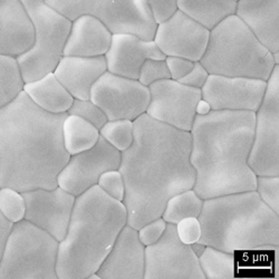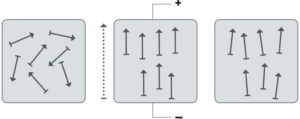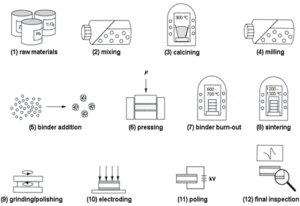How are piezoelectric ceramics made?
By Erling Ringgaard and Malte Aarenstrup Launbjerg
Piezoelectric ceramics are polycrystalline materials. They consist of many individual piezoelectric crystal grains formed during calcination and eventually pressed into a homogeneous solid. Barium titanate (BaTiO3) was the first piezoelectric ceramic to be produced, but today it has largely been replaced in industrial use by lead zirconate titanate (Pb[ZrxTi1-x]O3), commonly referred to as PZT.
Unlike piezoelectric single crystals, piezoelectric ceramics do not have a uniform and continuous crystal lattice. Instead, the individual grains are randomly oriented and separated by grain boundaries.

Crystal grains in PZT material separated by grain boundaries.
As the grains of the polycrystalline material are randomly oriented, so are the dipole domains within them. This will initially render the material unusable for piezoelectric purposes as a coordinated shift in charge distribution upon exposure to mechanical stress is impossible. Hence, poling of the material is required before it can acquire its piezoelectric functionality.

Dipoles in a piezoelectric material before, under and after poling.
Read more about the properties of piezoelectric materials here.
Advantages of piezoelectric ceramics
Piezoelectric ceramics hold distinct advantages over their single crystal counterparts. A major strength of piezoelectric ceramics is the ease with which they can be fabricated in a variety of shapes and sizes. This option is severely limited in the case of single crystals as their crystallographic uniformity dictates that they must be cut in certain directions. The high customizability of piezoelectric ceramics makes them very versatile as they can be manufactured to fit and support almost any application or machinery.
Another advantage of piezoelectric ceramics is that the manufacturing of them easily allows for various dopants to be added homogeneously, strengthening specific electrical or mechanical qualities of the material. This contributes further to the versatility of piezoelectric ceramics as not only their shape and size, but also their piezoelectric performance can be tailored to suit a specific function.
View our piezoelectric ceramic materials here.
How are piezoelectric ceramics made?
Piezoelectric ceramics are created through a multi-step production process. Although the exact procedure varies somewhat (and in some cases completely) from product to product, a general overview of the process of creating PZT-based materials can be seen below.

1) Raw materials
The different chemical components of the material in question are weighed and dosed in accordance with the specific prescription. At this point, dopants can be added to enhance certain mechanical or electrical qualities, though often at the expense of others. Some examples are given below:
Element substitution
Pb2+ replaced with Mg2+, Ca2+, Sr2+, Ba2+
Zr4+/Ti4+ replaced with Sn4+, Hf4+
Formation of A vacancies (soft doping)
Pb2+ replaced with La3+, Nd3+, Sb3+, Th4+
Zr4+/Ti4+ replaced with Nb5+, Sb5+, W6+
Soft doping will typically increase permittivity, coupling, dielectric loss and resistivity while decreasing stiffness, coercive field and mechanical quality factor.
View our soft PZT materials here.
Formation of oxygen vacancies (hard doping)
Pb2+ replaced with K+, Na+
Zr4+/Ti4+ replaced with Fe2+/3+, Co2+/3+, Mn2+/3+, Ni2+, Mg2+, Al3+, Ga3+, In3+, Cr3+, Sc3+
Hard doping will typically increase stiffness, coercive field and mechanical quality factor while decreasing permittivity, coupling, dielectric loss and resistivity.
View our hard PZT materials here.
Combining hard and soft properties
Zr4+/Ti4+ replaced with Ce4+, U6+
Increasing the doping level will in general decrease the Curie temperature of the end product.
2) Mixing
When the desired combination of and ratio between components have been achieved, the raw materials are mixed with additives and liquid in a ball mill.
3) Calcining
The mix of materials is calcinated at approximately 900 °C, generating its crystal structure.
4) Milling
The material is milled in order to achieve the desired particle size as well a homogenous suspension of its contents.
5) Binder addition
A polymeric binder is added to the mix in order to increase its mechanical strength after pressing.
6) Pressing
The material is pressed into the desired shape in which it will be produced.
7) Binder burn-out
To remove all organics, binders and solvents from the material, it is slowly heated to a temperature in the range of 600-700 °C.
8) Sintering
The material is heated under very high temperatures (1200-1300 °C) to stimulate the growth of the crystal grains and reach maximum density.
9) Grinding / polishing
The components are carefully worked to obtain the exact dimensional and surface specifications.
10) Electroding
Electrodes are deposited on the individual piezoceramic component.
11) Poling
The component is exposed to a high electric field, reorientating the otherwise randomly oriented dipoles within the crystal grains in same direction, making it piezoelectric.
12) Final inspection
The finished component will undergo a final inspection based on company guidelines and customer specifications. This will often include testing of its mechanical and electrical properties such as dimensions, capacitance, piezoelectric coupling etc.
 ENGLISH
ENGLISH





























































